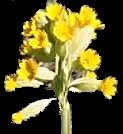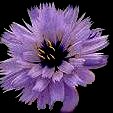|
**disclaimer: If any of the images belong to you and if you want credit or want them removed please email me**
MEANINGS & LEGENDS OF FLOWERS (C)

 Clover
Clover
Trifolium spp.
Family: Leguminosae
Common Names: ~Shamrock~ ~Trefoil~ ~Three-leaved Grass~ ~St. Patrick's Herb~ ~White Clover~ ~Red Clover~ ~Rabbit-Foot Clover~
The shamrock dates back to ancient Druids who used the Celtic name ~seanrog~ meaning ~little clover.~ It changed to ~shamroag~ and then to ~shamrock.~ In the Middle Ages it was seen as the symbol of the Trinity because it had three leaflets. Legend has it that when St. Patrick reached the Emerald Isle in the 5th century, he used three-leafed clovers to teach the Christian doctrine of the Trinity. It is said that Biblical sheep grazed upon it. Native to the Mediterranean region, the plant was called ~clava~ by the Romans, after their term for Hercules' mythological three-knobbed club. In Britain, it became the Anglo-Saxon ~cloefer~ or ~cloeferwort~ wort indicating a plant of medicinal virtue.
Tiny posts of bright green shamrocks appear on St. Patrick's Day. The small pale white and pink flowers have been used in healing ointments since ancient times. Three-leaf clovers, are important in weddings and matters of love. Symbolizing a prosperous, joyous, long marriage with happiness and good fortune, it is said to protect the household. No bride should go down the aisle without clovers present in both shoes.
Clover was an ancient protective herb. The Druids considered the trefoils, symbolic of the eternal verities of Earth, Sea and Sky. This is why most charms are repeated thrice. The Celts saw the clover as a sacred, magical plant. It is sometimes referred to Mary. The 4-leafed clover is a sign of good luck. The 5- leafed clover is seen as a token of good marriage. Clovers with more than 4 leaflets are seen as un-favorable. Considered good luck omens a four-leafed clover is a charm against snakes, witches, the devil and other dangerous creatures. Besides, it is said to give the gift of second sight enabling one to see fairies.
Common wild red clovers Trifolium pratense, are used as a tonic tea or skin wash. High in vegetable protein, red clover is a valuable forage crop.
Clover is seen as a sign of vitality. In the language of flowers clover means ~think of me~ or ~be mine~

 Columbine
Columbine
Aquilegia canadensis
Family: Ranunculaceae (Buttercup family)
Columbine is one of the most beautiful wildflowers. The plants are found growing in thin soil in limestone outcroppings, sometimes from a crack in the rocks. Columbine is the symbol of foolishness, based on the flower's resemblance to a jester's cap and bells. It was considered bad luck to give this flower to a woman. Fallen spurs of the columbine looked like the Virgin Mary's Shoes and received that name. They were said to have sprung up where Mary's feet touched the earth when she was on her way to visit Elizabeth. The spurred flowers resembled the tiny doves and came to represent the Holy Spirit. The flower also symbolized the innocence of Mary. The petals of the Columbine symbolize the seven gifts of the Spirit. The wild columbine has only five petals.

 Comfrey
Comfrey
Symphytum officinale
Family: Boraginaceae
Common Names: ~Boneset~ ~Bruisewort~ ~Knit Back~ ~Knit Bone~ ~Slippery Root~ ~Black Wort~ ~Healing Herb~ ~Miracle Herb~ ~Wallwort~ ~Ass Ear~ ~Nipbone~ ~Salsify~ ~Consound~ ~Gum Plant~ ~Invisible Vet~ ~Consolida~
Comfrey gets it's name from the Latin word ~conferva~ meaning ~knitting together~ from the plant's power to heal broken bones. Its botanical name, Symphytum, means ~grown together.~
Native of Russia, comfrey has long been used for food and medicinal purposes. The Greeks and Romans used comfrey for a variety of ailments ranging from external application for wounds and fractures to stomach disorders.
Comfrey is commonly used to make tea. It is also useful as a slug trap. It has the ability to clean and extract nutrients from stagnant or foul water. Its long tap roots can go as deep as 10 feet enabling it to accumulate minerals in its' leaves. It has been promoted in the past as a forage crop. Comfrey is used as fodder for livestock and gardeners state that it enriches compost.
Good for any magical healing. Worn or carried, it ensures safety during travel. To ensure the safety of your luggage while traveling, tuck a peice of the root into each bag. The root is used in money spells.

 Compass Flower
Compass Flower
Silphium laciniatum
Family: Asteraceae (Compositae)
~Silphium~ is a Greek word relating to its ~resinous juice~ and ~laciniatum~ is Latin for ~slashed.~
This flower lifts its head from the meadow and its leaves point to the north like a magnet. It is said that the finger of God is suspended on its fragile stalk, to direct the traveler's journey. It was used as a tonic and was used by settlers for the treatment of rheumatism and glandular enlargements. The upper third of the stems produce a gummy material when the plant is in bloom. This gummy material was used by American Indians and pioneer children as chewing gum.

 Coriander
Coriander
Coriandrum sativum
Family: Umbelliferae
Common Names: ~Cilantro~ ~Chinese Parsley~
Indian Name: Dhania
It originated in southern Europe and reached other parts of the world centuries ago. It is one of the most common herbs in the Middle East and Mexico. Coriander was named after the bedbug emitting the same odor. Its use dates back to 5,000 BC. References to coriander are found in ancient Sanskrit texts, Egyptian papyrus records (coriander seeds were placed in Egyptian tombs), and the Bible. The herb is recorded in the Han Dynasty in China. Coriander plants were growing in Massachuessetts by the 1600's, and are one of the first herbs grown by the American colonists. In the 17th century Frenchmen used distilled coriander to make a type of liquor.
Ancient Hebrews in their Passover meal and ancient Romans used cilantro to cure meat. In One Thousand and One Arabian Nights, it is described as an aphrodisiac. Ancient Egyptians and Greeks also believed that it had aphrodisiacal properties. Dioscorides, a Greek physician, believed ingesting coriander spice could heighten a man's sexual potency.
Coriander has lacy-fern-like leaves with little white flowers. All parts of the plants are used for culinary purposes. The seeds are used in flavoring many dishes, the leaves are added to salads, and the roots are cooked like a vegetable. Cilantro is one of the most common herbs in Mexican cooking.
In the Middle Ages it was used in love potions and spells and when added to wine. The Chinese believed it imparted immortality. It was thought that when an expecting lady eats coriander, the child to be will be a genious.
The seeds are used in making teas used as a digestive aid. The oil from the seeds is used to disguise the flavors of other medicines and the oil is also used in oinments for painful rheumatic joints and muscles.

 Cosmos
Cosmos
Cosmos bipinnatus
Family: Asteraceae
Native from Mexico to Brazil, Cosmos means ~orderly,~ ~beautiful~ and ~ornanmental~ in Greek.
Cosmos are used as background plants or as cut flowers. They bloom in the early summer to frost. They disperse readily through seed.

 Cowslip
Cowslip
Primula veris
Family: Primulaceae
Common Names: ~Paigle~ ~Peagles~ ~Primrose~ ~Herb Peter~ ~Key Flower~ ~Our Lady's Keys~ ~Key of Heaven~ ~Herb Peter~ ~Primrose~
The origin of Cowslip is a corruption of ~Cow's Leek~ derived from the Anglo-Saxon word ~leac~ meaning a ~plant.~ It is called ~Key Flower~ as it resembles ~a bunch of keys,~ the emblem of St. Peter. It was also called ~Herb Peter.~ According to legend, one day, St. Peter heard a rumor that people were trying to enter heaven by the back door, instead of the front gates of which he holds the key. He was so agitated at this lack of reverence, that he dropped his bunch of keys, which fell to earth, took root and cowslips bloomed which in Germany are known as ~Himmelschlüsselchen,~ meaning the ~little keys of heaven.~ In Norse mythology the flower was dedicated to Frcya, the Key Virgin. In northern Europe the idea of dedication to the goddess was transferred with the change of religion, and it became dedicated to the Virgin Mary, so it is called ~Our Lady's Keys~ and ~Key of Heaven~ and ~Keyflower.~
The mysterious number of petals represent women. They symbolize birth, consummation and death. It was held sacred by Druids. Primroses were considered fairy flowers in Ireland and Wales. They represented wantonness in England. Fairies love and protect cowslips. Touching a fairy rock with a primrose posy opens the way to fairyland and fairy gifts. Using the wrong number of flowers in the posy spells certain doom. It is used for love spells and for protection. Also for healing and youth to find treasures, especially hidden fairy gold.
The flowers are used for making Cowslip wine. Primrose pottage was made by boiling pounded flowers, honey, almond milk, saffron, rice flour and powdered ginger. It was served garnished with flowers. Leaves are edible, fresh or cooked, made into tea or wine.
Children make Cowslip Balls, or ~tosties~ from the flowers. The umbels are picked off close to the top of the main flowerstalk and about fifty to sixty are hung across a string which may be stretched for convenience between the backs of two chairs. The flowers are then pressed carefully together and the string tied tightly so as to collect them into a ball.
See * Primrose

 Crocus
Crocus
Crocus sativus
Family: Iridaceae
Saffron is mentioned in a writing on papyrus about 1500 before Christ. It was widely grown from Crete to England, where its stigmas were used for herbal and medicinal purposes. The crocus was greatly valued in the ancient world. In India it's called kesar and highly prized. A flower of ritual and ornament, it was also used as food and as a source of dye and was connected with ceremonies. Its petals were scattered on the ground at social gatherings and on the matrimonial bed after a wedding. Crocus essence was used as a perfume and the stamens of autumn-flowering Crocus sativus are the source of saffron.
According to legend, young Crocus was a shepherd boy of fine and noble spirit. He fell deeply in love with the lovely nymph Smilax. The gods were so impressed with the depth of his devotion, that they granted him immortality and turned him into a flower. To ensure that they could be forever together, Smilax was transformed as an evergreen, the yew.
According legend about the crocus is connected to Valentine's Day. Valentinus was a 3rd century Roman physician who administered natural remedies. He was also a practicing Christian priest and prayed for his patients' healing. Unfortunately, Christian practices were not permitted under the reign of Claudius II, and Valentine was arrested and sentenced to death.
The jailor's blind daughter was one of Valentine's patients. Just before his excecution, Valentine handed the jailor a note for the blind girl. In the note, he had wrapped a yellow crocus, the source of one of his healing herbs, saffron. As the jailor's blind daughter opened the note, her sight was restored and the first flower she saw was the yellow crocus which rivals the sun in its brightness. On the note, the physician had penned the following message:
~From your Valentine.~ It was the physician's last message and the world's first valentine. The day was February 14, 270 AD.
See * Saffron
  Cupid's Dart
Cupid's Dart
Catananche caerulea
Family: ~ Asteraceae~
Common Names: ~Cupidone~
The name for this plant comes from the Greek word for ~spell~ and ~compulsion.~ The flower was thought to inspire passion like Cupid's heavenly arrows. It is suitable for drying. The flower was used in love potions.
|


Copyright © Pinkie D'Cruz 1998
Friday, January 16, 1998


|

